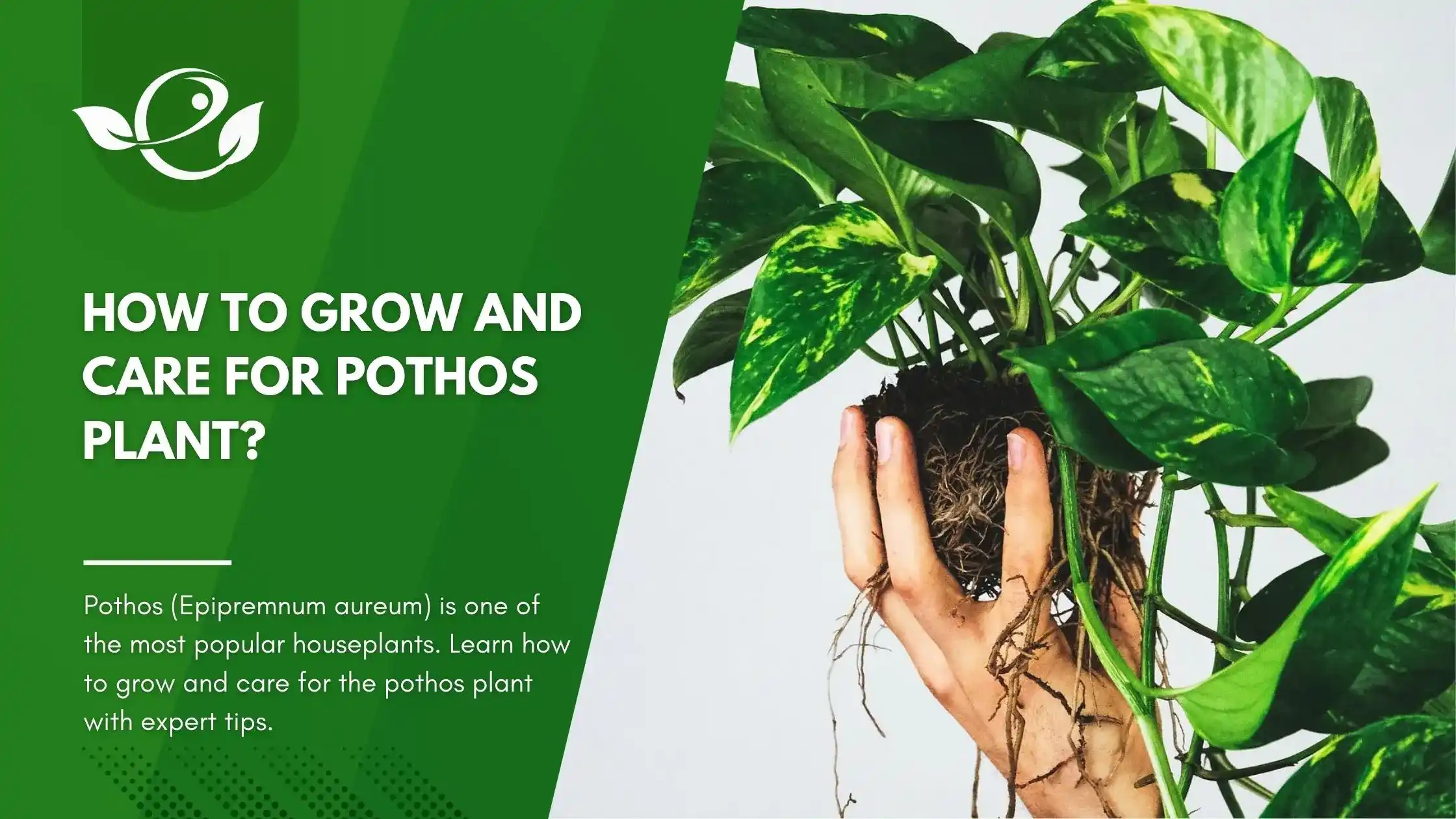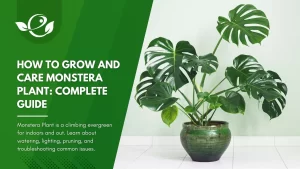Table of Contents
Pothos (Epipremnum aureum) is one of the most popular houseplants in the United States. Originating from the tropical regions of the South Pacific, this vine is renowned for its heart-shaped, variegated leaves and its ability to thrive in low to moderate light conditions. Whether you’re a novice gardener or a seasoned plant parent, learning the proper pothos plant care routine will not only ensure a healthy plant but also enhance your home décor with its lush, trailing vines. In this article, we’ll explore everything you need to know about pothos plant care—from understanding its natural characteristics to mastering advanced propagation methods—so you can transform your indoor space into a lush, green oasis.
Understanding Your Pothos Plant
Botanical Background
The pothos plant is a tropical vine native to the Solomon Islands. Its botanical name is Epipremnum aureum. In its natural habitat, pothos climbs trees under the canopy of dense forests. Indoors, its vigorous, trailing habit makes it ideal for hanging baskets, shelves, or even for training along a decorative trellis.
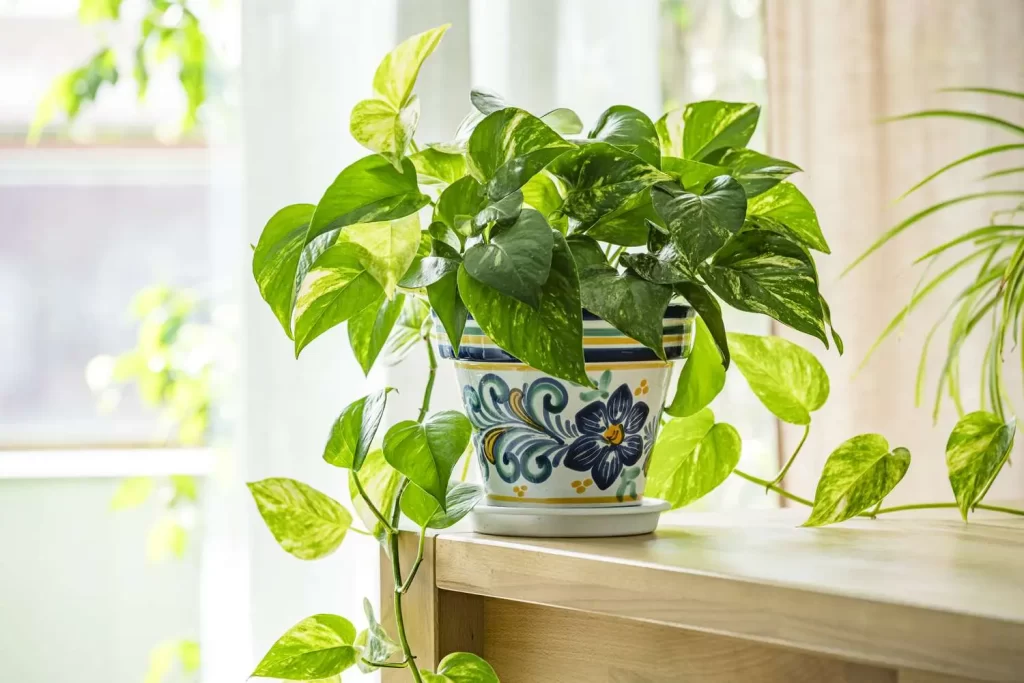
Key Details
| Attribute | Value |
|---|---|
| Common Name | Pothos, Devil’s Ivy, Golden Pothos |
| Botanical Name | Epipremnum aureum |
| Plant Type | Evergreen Perennial Vine |
| Hardiness Zones | USDA Zones 10–12 |
| Native Range | Tropical regions (native to the Solomon Islands in the South Pacific) |
| Light Requirements | Thrives in bright, indirect light; tolerates low light but may lose variegation in deep shade |
| Watering | Water when the top 1–2 inches of soil are dry; avoid overwatering to prevent root rot |
| Soil Type | Well-draining, rich, and airy (a mix of potting soil with perlite and orchid bark is ideal) |
| Growth Habit | Trailing or climbing, making it versatile for hanging baskets or training on a support |
| Toxicity | Contains calcium oxalate crystals; toxic if ingested by pets or children |
Benefits of the Pothos Plant
- Low Maintenance: Requires minimal care and can tolerate occasional neglect, making it perfect for beginners and busy households.
- Versatile Growing Conditions: Adapts well to a range of light environments—from low light to bright, indirect light—although the best variegation appears in brighter conditions.
- Air Purification: Helps remove indoor pollutants like formaldehyde and benzene, contributing to cleaner and healthier indoor air quality.
- Decorative Appeal: With its trailing vines and heart-shaped, variegated leaves, it adds a touch of tropical elegance to any room. It can be displayed in hanging baskets, on shelves, or trained along a trellis.
- Easy Propagation: Can be easily propagated using stem cuttings, allowing you to expand your collection or share with friends effortlessly.
- Adaptability: Thrives in various container setups and can be trained to climb or cascade, offering multiple design options for interior decoration.
- Robust and Resilient: Known for its fast growth and ability to bounce back from stress, making it an ideal option for diverse indoor environments.
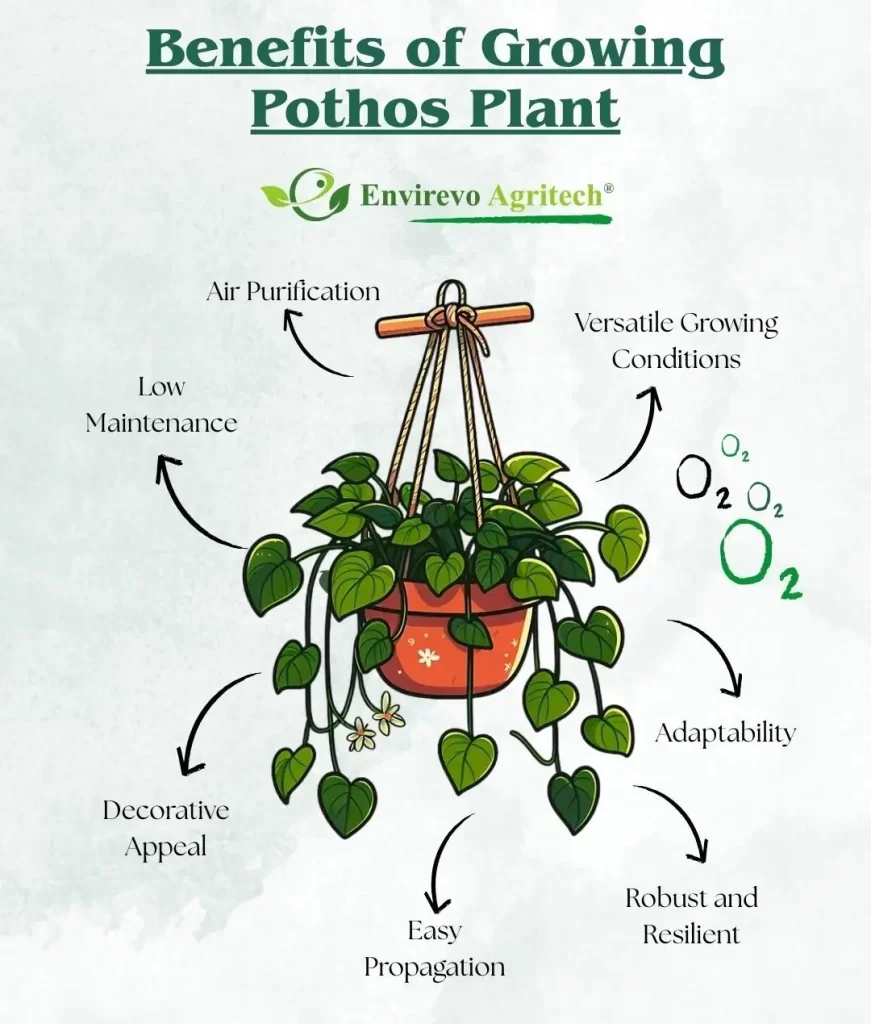
Popular Pothos Plant Varieties
1. Golden Pothos
The Golden Pothos is the classic version of this adaptable houseplant. It features heart-shaped leaves that are typically a deep, glossy green. Many specimens exhibit subtle variegation, giving them a warm, golden hue on the underside or along the margins. Vigorous trailing vine that can extend up to 10 feet or more. Exceptionally tolerant of low-light conditions, though brightness enhances variegation. Ideal for beginners due to its resilience.

2. Marble Queen Pothos
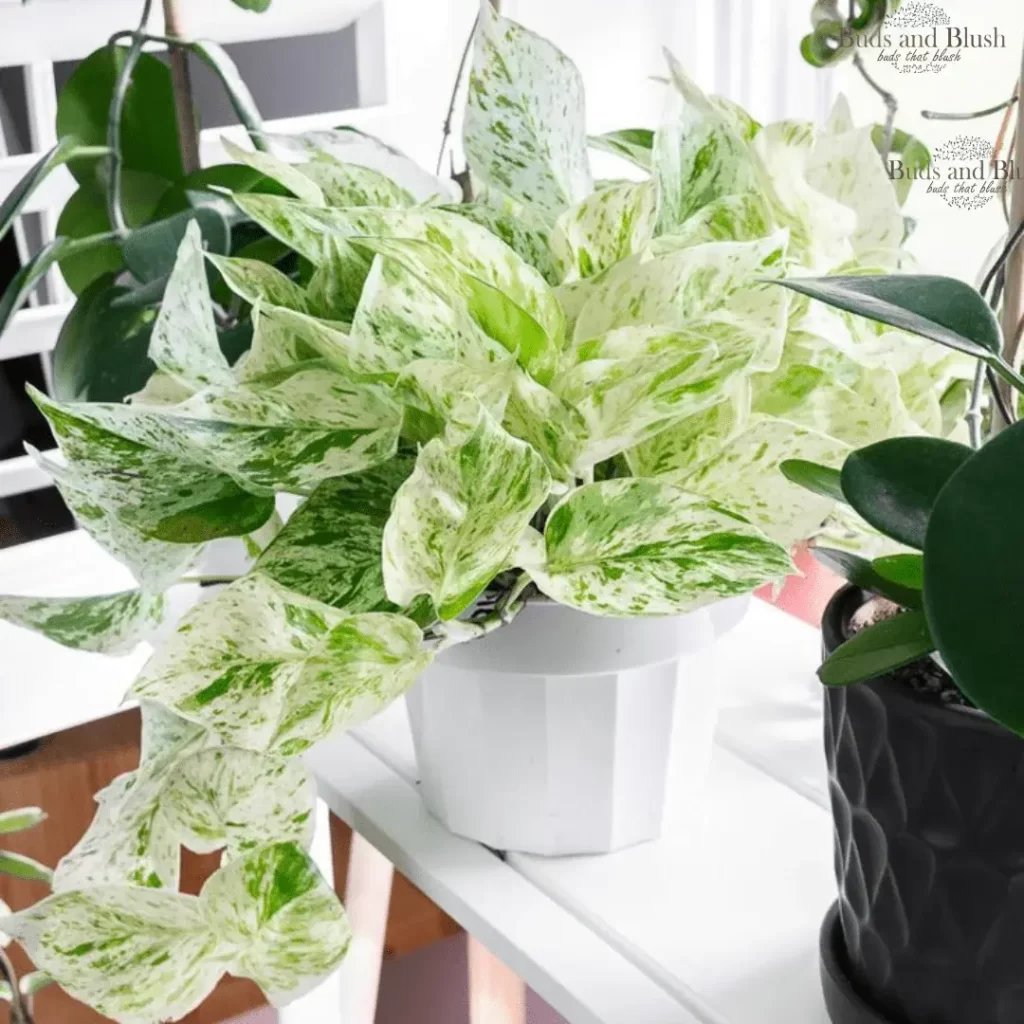
Marble Queen Pothos stands out because of its dramatic variegation. With splashes of white or cream on deep green leaves, this cultivar creates a striking visual accent in any room. High contrast variegation requires slightly more care; low light may cause the white markings to fade. Trailing or climbing vine that is excellent in hanging baskets or as a desk accent. Often used to add a bright, elegant touch to modern décor.
3. Jade Pothos
Jade Pothos, sometimes seen as the unvariegated form of pothos, boasts rich, dark green, glossy leaves. Its uniform color gives a classic tropical look that pairs well with various interior styles. Jade Pothos are extremely hardy and drought-resistant. Fewer variegation patterns can sometimes mean a lower maintenance routine. Perfect for spaces where you want a deep green backdrop without the distraction of variegation.
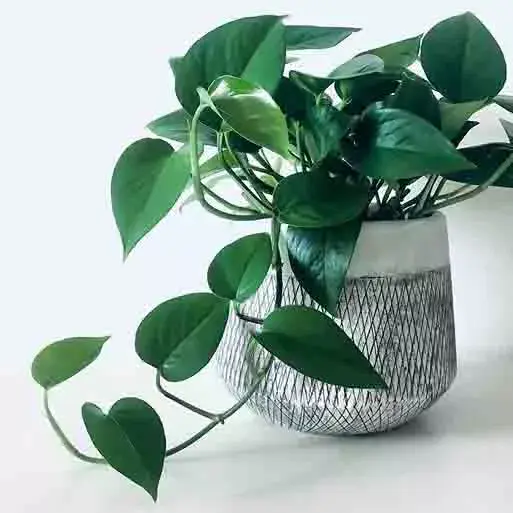
4. Neon Pothos
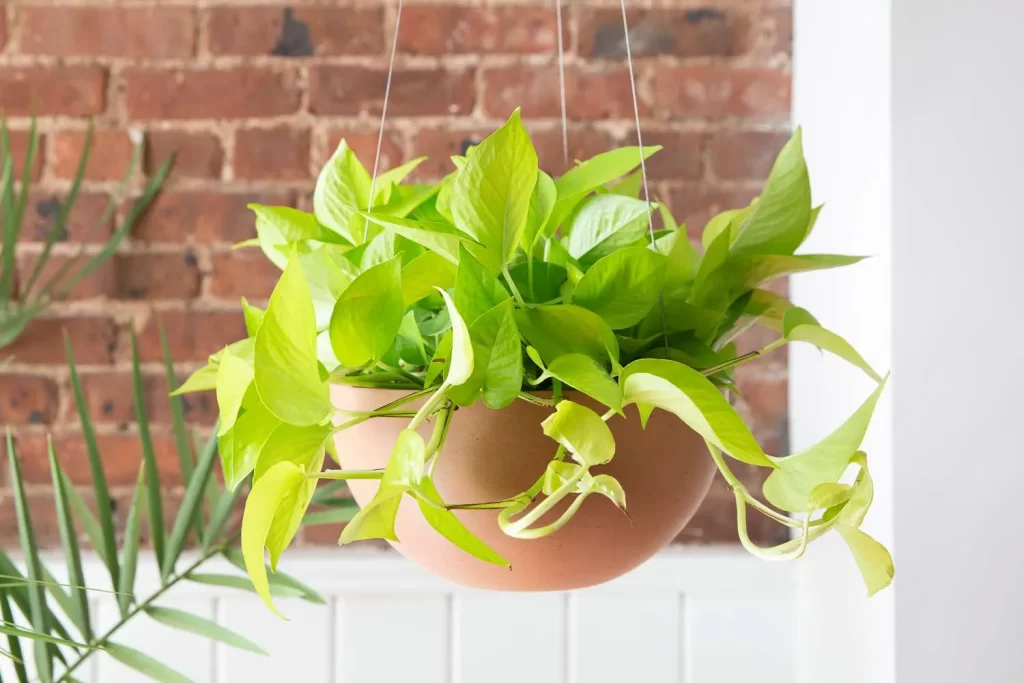
Neon Pothos is known for its striking neon-green foliage that adds a pop of color to any indoor setting. Its luminous appearance makes it a favorite among those seeking a statement plant. Neon Pothos maintains a bright, eye-catching green under the right lighting conditions. It can trail elegantly from shelves or hanging baskets. The vibrant color is a natural conversation starter in any space.
5. N’Joy Pothos
N’Joy Pothos is celebrated for its pronounced variegation. The leaves typically display vivid white markings across a backdrop of deep green, making it both elegant and distinctive. Tends to be slower growing than the Golden Pothos, which contributes to a denser, fuller appearance. Requires ample light to preserve its high-contrast pattern. The intricate white markings create a subtle yet sophisticated look.

6. Manjula Pothos
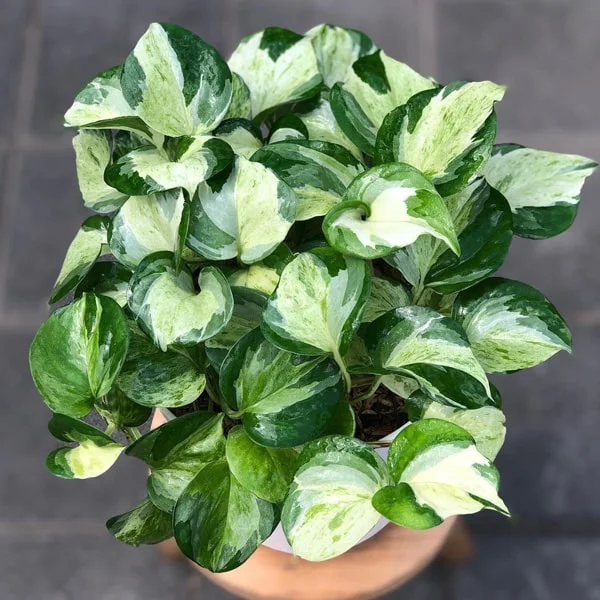
Manjula Pothos features larger, heart-shaped leaves with a mix of deep green, cream, and white variegation. This variety exudes a refined tropical charm while offering a bushier growth habit when pruned correctly. Manjula Pothos are highly attractive variegation that draws the eye; each leaf presents a unique pattern. It can be trained both as a trailing plant and as a climbing vine. Pruning can create a full, lush appearance suitable for prominent display areas.
Pothos Plant Care
Light Requirements
Pothos plants naturally grow in the filtered light of tropical forests. Indoors, they thrive best with bright, indirect light. Here are some key pointers:
- Optimal Placement: Situate your plant near an east- or west-facing window where it can receive ample diffused light.
- Tolerance: While pothos can tolerate low light conditions, prolonged lack of light may result in slower growth and reduced variegation.
- Avoid Direct Sunlight: Too much direct sunlight can scorch the delicate leaves, causing irreversible burn marks.
Temperature and Humidity
Maintaining the right temperature and humidity is crucial for healthy pothos growth: Pothos grows best in temperatures between 65°F and 85°F (18°C to 29°C). Avoid sudden drops below 50°F, which can stress the plant. Average U.S. indoor humidity is usually sufficient, but pothos benefits from higher humidity during the winter months. Use a humidifier, pebble tray, or group plants together in naturally humid rooms (such as kitchens or bathrooms).
Watering Practices
Watering is one of the most critical aspects of pothos plant care: Allow the top 1–2 inches of soil to dry out before watering. This prevents overwatering, which can lead to root rot. Drooping leaves indicate the plant might be thirsty, while yellowing leaves can be an early sign of overwatering. Use a watering can with a fine spout to ensure even distribution and always empty excess water from the saucer under the pot.
Soil Mix and Drainage
Pothos plants require a well-draining soil mix to prevent waterlogging: A light, airy mix works best. You can combine standard potting soil with perlite and orchid bark to create a balanced medium. Ensure your pot has drainage holes to allow excess water to escape, minimizing the risk of root rot.
Fertilizing Your Pothos
Proper fertilization supports vigorous growth: Feed your pothos with a balanced liquid fertilizer once a month during spring and summer. Reduce or suspend fertilization during fall and winter when the plant’s growth naturally slows. Occasionally top dress the soil with compost or seaweed extract to provide additional nutrients.
How to Prune Pothos Plants
Pruning your pothos is one of the simplest yet most effective ways to keep your plant healthy and promote a fuller, bushier growth habit. Here are some key points to consider when pruning your pothos plant:
- Timing: It’s best to prune during the active growing season (spring or summer) when the plant is most likely to produce rapid, vigorous new growth. Avoid heavy pruning during winter, when growth is naturally slower.
- Tools: Always use a pair of sharp, sterilized pruning shears or scissors. This minimizes stress on the plant and reduces the risk of transmitting diseases.
- Pruning Technique: Trim just above a leaf node (the point where a leaf is attached) to encourage the plant to branch out. Removing no more than about one-third of the plant at a time prevents excessive stress. Regular, moderate pruning keeps the vines neat, removes any leggy or dead sections, and improves the overall appearance of the plant.
How to Propagate Pothos Plant
1. Stem Cuttings in Water
Choose a healthy vine with at least 3–4 nodes (the small bumps along the vine where leaves attach). Using sterilized scissors or pruning shears, cut a 4–6 inch section. Remove the leaves from the bottom 1–2 nodes to expose the stem. Place the cutting in a container filled with water, ensuring that the exposed nodes are submerged. Change the water every 7–10 days to prevent bacterial growth. Once roots develop (about 1–2 inches long), transplant the cutting into a pot with well-draining soil.
2. Direct Propagation in Soil
After taking a cutting as described above, you can plant it directly into moist, well-draining potting mix. Keep the soil lightly moist and place the pot in a bright, indirect light location. Covering the cutting with a clear plastic bag can help retain humidity and speed up rooting, but make sure to remove it periodically for air exchange.
Potting and Repotting Pothos Plant
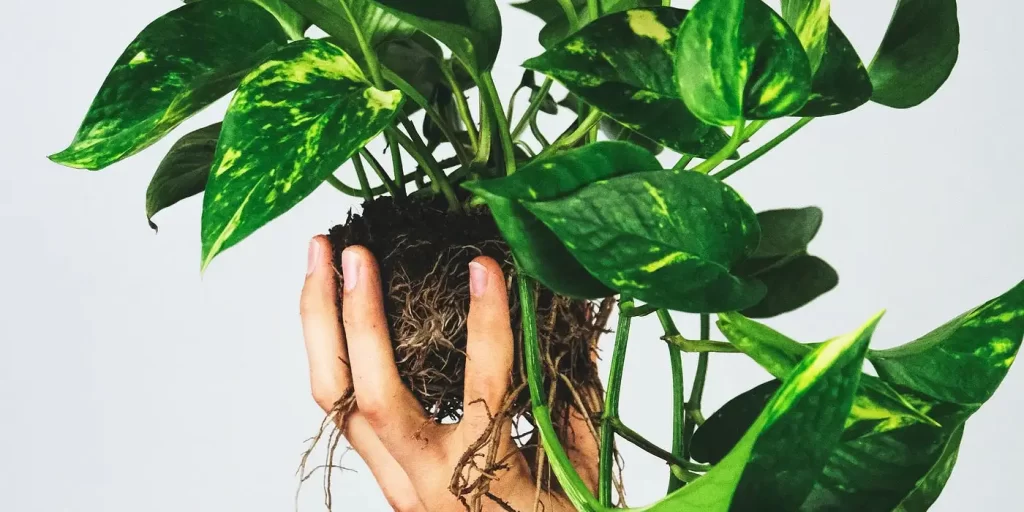
Potting and repotting are essential steps to keep your pothos thriving and its roots healthy. Here are some key points and best practices:
- Choosing the Right Container: Select a pot that is 1–2 inches larger in diameter than your current one and equipped with drainage holes. A slightly snug container helps prevent overwatering while giving space for root growth.
- Soil Mix: Pothos plants prefer a light, well-draining potting mix. A recommended blend is one part standard potting soil, one part perlite, and one part orchid bark. This mix provides sufficient aeration and prevents waterlogging, which can lead to root rot.
- When to Repot: Repot your pothos every 1–2 years or when you notice signs that the plant is root-bound, such as roots poking out of the drainage holes or a decline in growth. Repotting not only gives the roots more room to expand but also refreshes the soil nutrients.
- Repotting Process:
- Remove the Plant: Gently take the pothos out of its current container, being careful not to damage the roots.
- Loosen the Roots: Lightly tease the roots and remove the old soil to free any tangled roots.
- Place in a New Pot: Position your plant in the center of the new container and fill around the root ball with fresh soil mix.
- Water Thoroughly: After repotting, water the plant deeply to help settle the new soil and eliminate any air pockets.
Aftercare Tips: Keep the newly repotted pothos in a location with stable, indirect light and avoid fertilizing for a few weeks as it adjusts. Monitor soil moisture closely during this transition to ensure that the plant recovers without the stress of over- or underwatering.
Troubleshooting Common Issues With Pothos Plant
1. Leaves Turning Yellow
Yellowing leaves are among the most common signs of stress in pothos, and they may indicate several underlying problems. If the soil remains soggy for extended periods, roots can rot, leading to insufficient water and nutrient uptake. Check that your pot has proper drainage and allow the top 1–2 inches of soil to dry before watering again. Conversely, if watering is too infrequent, the leaves may turn yellow as a signal of dehydration. Monitor the moisture level by feeling the soil; slight drooping may indicate it’s time to water. A lack of essential nutrients, especially nitrogen, can cause yellowing. Incorporate a balanced, water-soluble fertilizer during the growing season to supplement any deficiencies.
2. Browning Leaf Tips
Browning tips are a common issue that often points to environmental imbalances: Pothos thrive in moderate humidity. In drier environments—particularly during winter—leaf tips may turn brown. Boost humidity by using a humidifier, placing a pebble tray beneath the plant, or misting the leaves occasionally. Fluctuations between overwatering and underwatering can cause dehydration at the leaf margins. Keep a regular watering schedule that allows the soil to dry slightly between waterings.
3. Leggy or Sparse Growth
A leggy, sparse pothos often indicates that the plant is not reaching its light requirements: Pothos vines elongate when they stretch toward a light source. If your plant is growing long, thin vines, consider moving it to a spot that receives bright, indirect light for several hours per day. Insufficient nutrients may also contribute to weak, leggy growth. Ensure you’re feeding the plant during spring and summer with a balanced liquid fertilizer.
4. Dropping Leaves
Although natural aging involves the shedding of older leaves, excessive leaf drop often signals stress: Sudden changes in temperature, humidity, or exposure to drafts can cause the plant to drop leaves. Maintain a stable environment and avoid moving the plant abruptly. Both overwatering and underwatering can lead to leaf drop. Adjust your watering routine so that the soil isn’t too wet or too dry. If the pothos becomes root-bound, the stress on the roots may result in leaf shedding. Repot the plant every 1–2 years to provide fresh soil and additional space for root expansion.
5. Black Spots on Leaves
Black spots on the foliage may be indicative of several potential issues, including: Overly moist and stagnant soil can encourage fungal growth. Remove affected leaves and adjust the watering regimen to let the soil breathe. In severe cases, a mild fungicide may be required. Insects such as mealybugs or scale can cause lesions that later darken into black spots. Inspect the underside of leaves and along the stems for tiny pests, and treat with insecticidal soap or neem oil if necessary.
6. Sunburn and Light Stress
Direct sunlight or overly intense light can be harmful even for hardy pothos plants: Look for bleached or scorched spots on the leaves, which might appear as patchy discoloration. The edges may become crisp and dry. Although pothos tolerate low-light conditions, prolonged exposure to direct sunlight is harmful. Use sheer curtains or relocate the plant to an area with filtered or indirect light.
Common Pests & Diseases
| Pest/Disease | Common Cause | Signs to Look For |
|---|---|---|
| Spider Mites | Dry, warm conditions; low humidity | Fine webbing on the plant; yellowing or speckled leaves. |
| Mealybugs | Over-fertilization; excessive nitrogen levels | White, cottony clusters on leaf axils and undersides; sticky honeydew residue. |
| Aphids | Overcrowded plants; excessive nitrogen fertilization | Clusters of small, pear-shaped insects on new growth; distorted or curling leaves; sticky honeydew. |
| Thrips | Overcrowded conditions; presence of weeds or infested plants nearby | Silvery streaks or speckled leaves; black droppings; deformed growth. |
| Scale Insects | Warm, dry environments; lack of natural predators | Brown or tan, dome-shaped bumps on stems and leaves; yellowing foliage; sticky honeydew. |
| Fungus Gnats | Overwatering; damp, organic-rich soil | Tiny black flies around the plant; larvae in the soil; sudden wilting. |
| Root Rot | Poor drainage; overwatering | Yellowing leaves; wilting; mushy, blackened roots; foul odor from soil. |
| Bacterial Leaf Spot | High humidity, overhead watering, poor air circulation | Water-soaked spots with yellow halos; spots may coalesce; leaf drop. |
| Southern Blight | Warm, moist conditions; contaminated soil or tools | Rapid wilting; brown lesions on stems near soil line; white, fan-like fungal growth. |
| Powdery Mildew | High humidity, overhead watering; poor air circulation | White, powdery fungal growth on leaves and stems; distorted growth; premature leaf drop. |
Final Thoughts
Pothos plant care is both straightforward and rewarding. By providing the right light, temperature, moisture, and a well-draining soil mix, you can enjoy a thriving pothos plant that enhances your indoor environment with its lush, vibrant foliage. From propagation to styling, the versatile pothos adapts to various décor styles and brings the tropical beauty into your home. Whether you’re learning the basics or mastering advanced propagation techniques, a bit of regular care will ensure your pothos remains a centerpiece of natural elegance in your space.
Happy gardening, and may your pothos plant grow ever fuller!
